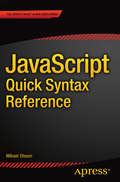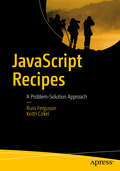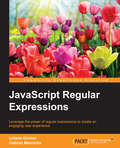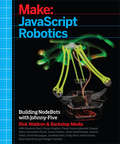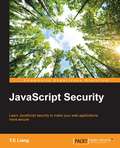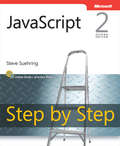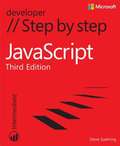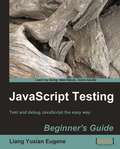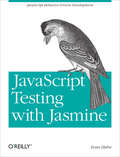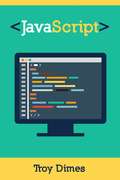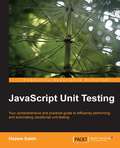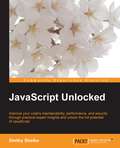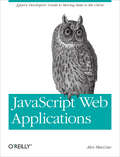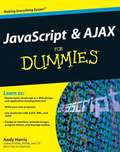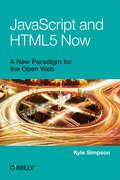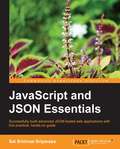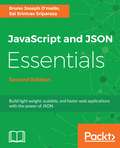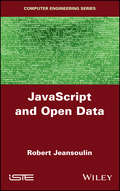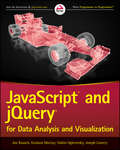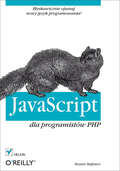- Table View
- List View
JavaScript Quick Syntax Reference
by Mikael OlssonJavaScript Quick Syntax Reference is a condensed syntax reference to the JavaScript language. It presents the essentials of JavaScript in a well-organized format that can be used as a handy reference. This includes the latest ECMAScript 5, JSON (JavaScript Object Notation) and DOM (Document Object Model) specifications and implementations. You won't find any technical jargon, bloated samples, drawn out history lessons or witty stories in this book. What you will find is a JavaScript reference that is concise, to the point and highly accessible. The book is packed with useful information and is a must-have for any JavaScript programmer or Web developer. In JavaScript Quick Syntax Reference, you will find a concise reference to JavaScript programming language syntax; has short, simple and focused code examples; and includes a well laid out table of contents and a comprehensive index allowing easy review. What you'll learn What is the lexical structure of the latest JavaScript and ECMAScript 5 What are types, values, variables, expressions, operators and statements How to use objects, arrays, functions, classes, and regular expressions What are DOM and JSON and how to use them How to effectively implement both client-side and server-side JavaScript code Who this book is for This book is a handy, pocket quick scripting syntax reference for those experienced in JavaScript as well as programmers, web developers, tinkerers and people new to JavaScript. Table of Contents 1 Using JavaScript 2 Variables 3 Operators 4 Arrays 5 Strings 6 Conditionals 7 Loops 8 Functions 9 Closures 10 Objects 11 Events 12 DOM 13 Cookies 14 Error handling
JavaScript Recipes
by Russ Ferguson Keith CirkelQuickly discover solutions to common problems, best practices you can follow, and everything JavaScript has to offer. Using a problem-solution approach, this book takes you from language basics like built-in objects and flow control all the way to advanced optimization techniques, frameworks and Node. js. With JavaScript Recipes you will learn language fundamentals like types, conversions, execution contexts, expressions, operators, statements, and built-in objects. You'll explore and make the most of your script's host environment and how to create your own JavaScript host using Google's V8 engine. Employ advanced optimization techniques to create scripts that execute as fast, or faster, than native executables. JavaScript Recipes shows you how to avoid wasting development time and concentrate on developing cutting-edge applications. You'll see how much quicker and efficient it is to develop with JavaScript. Start becoming a JavaScript pro with JavaScript Recipes today. What You'll Learn Learn JavaScript language fundamentals and what they can do for you Use JavaScript's powerful features to develop next-generation applications Explore your script's host environment and extend it with your own objects Learn how to use Google's V8 Engine to create your own JavaScript environment Learn advanced optimization techniques Implement advanced techniques like closures, namespaces, and reflection How to use Node. js efficiently Who This Book Is For JavaScript developers who need to get development tasks accomplished quickly.
JavaScript Regular Expressions
by Gabriel Manricks Loiane GronerThis book is ideal for JavaScript developers and programmers who work with any type of user entry data and want sharpen their skills to become experts.
JavaScript Robotics: Building NodeBots with Johnny-Five, Raspberry Pi, Arduino, and BeagleBone
by Lyza Danger Gardner Emily Rose Anna Gerber Sara Gorecki Backstop Media Bryan Hughes Pawel Szymczykowski Andrew Fisher Jonathan Beri Rick Waldron Kassandra Perch Donovan Buck David Resseguie Susan Hinton Raquel Velez Julian David DuqueJavaScript Robotics is on the rise. Rick Waldron, the lead author of this book and creator of the Johnny-Five platform, is at the forefront of this movement. Johnny-Five is an open source JavaScript Arduino programming framework for robotics. This book brings together fifteen innovative programmers, each creating a unique Johnny-Five robot step-by-step, and offering tips and tricks along the way. Experience with JavaScript is a prerequisite.
JavaScript Security
by Y. E LiangThis book is for JavaScript developers having basic web development knowledge and also for those who want to explore the security issues that arise from the use of JavaScript. Prior knowledge of how JavaScript is used, such as for DOM manipulation or to perform Ajax operations, is assumed.
JavaScript Step by Step
by Steve SuehringYour hands-on, step-by-step guide to the fundamentals of JavaScript development. Teach yourself how to program with JavaScript -- one step at time. Ideal for developers with fundamental programming skills, this practical tutorial provides the clear guidance and hands-on examples you need to create or customize interactive Web applications using core JavaScript features and techniques. Discover how to: Write and deploy JavaScript code with Microsoft® Visual Studio® 2010, the Eclipse IDE, or text editors Work with JavaScript syntax and data types Use the Document Object Model to retrieve, create, and change HTML elements Create rollover images and slideshow effects Validate and provide feedback for user input on Web forms Manipulate CSS styles and respond to browser events Develop interactive Web applications using AJAX Help speed development with JavaScript frameworks such as jQuery Your Step by Step digital content includes: All the books practice files -- ready to download and put to work. Fully searchable online edition of this book -- with unlimited access on the Web. The print version of this book includes free digital content online. To download, please visit O'Reilly's web site, search for the title of this book to find its catalog page, and click on the link below the cover image (Examples, Companion Content, or Practice Files). Note that while we provide as much of the media content as we are able via free download, we are sometimes limited by licensing restrictions. Please direct any questions or concerns to booktech@oreilly.com.
JavaScript Step by Step
by Steve SuehringGet the hands-on, step-by-step guide to learning JavaScript for Web development. Even with no programming experience, you can teach yourself the essentials of working with the JavaScript programming language--one step at a time. With STEP BY STEP, you work at your own pace through hands-on, learn-by-doing exercises. Whether you're building skills for your career or just want to customize your personal Web site, you'll learn the core capabilities and fundamental techniques for working with JavaScript--and begin creating professional-looking Web sites. Includes a companion CD with practice exercises, code samples, data sets, and a fully searchable eBook. A Note Regarding the CD or DVD The print version of this book ships with a CD or DVD. For those customers purchasing one of the digital formats in which this book is available, we are pleased to offer the CD/DVD content as a free download via O'Reilly Media's Digital Distribution services. To download this content, please visit O'Reilly's web site, search for the title of this book to find its catalog page, and click on the link below the cover image (Examples, Companion Content, or Practice Files). Note that while we provide as much of the media content as we are able via free download, we are sometimes limited by licensing restrictions. Please direct any questions or concerns to booktech@oreilly.com.
JavaScript Testing Beginner's Guide
by Liang Yuxian EugeneThis book is organized such that only the most essential information is provided to you in each chapter so as to maximize your learning. Examples and tutorials are given in an easy to follow, step-by-step manner so that you can see how the testing process is being carried out and how the code is being written. The source code also contains detailed explanation so that you know what the code is doing. Multiple screenshots are used in places that matter so that you have a visual sense of what is happening. Beginner JavaScript developers looking for essential ways to write, test, and debug JavaScript for different purposes and situations.
JavaScript Testing with Jasmine: JavaScript Behavior-Driven Development
by Evan HahnGet a concise introduction to Jasmine, the popular behavior-driven testing framework for JavaScript. This practical guide shows you how to write unit tests with Jasmine that automatically check for bugs in your application. If you have JavaScript experience—with knowledge of some advanced features—you’ll learn how to write specifications for individual components, and then use those specs to test the code you write.Throughout the book, author Evan Hahn focuses primarily on methods for testing browser-based JavaScript applications, but you’ll also discover how to use Jasmine with CoffeeScript, Node.js, Ruby on Rails, and Ruby without Rails. You won’t find a more in-depth source for Jasmine anywhere.Get an overview of both test-driven and behavior-driven developmentWrite useful specs by determining what you need to test—and what you don’tTest the behavior of new and existing code against the specs you createApply Jasmine matchers and discover how to build your ownOrganize code suites into groups and subgroups as your code becomes more complexUse a Jasmine spy in place of a function or an object—and learn why it’s valuable
JavaScript Una Guía de Aprendizaje para el Lenguaje de Programación JavaScript
by Troy Dimes Andrés ParraudJavaScript es un lenguaje de programación de computadoras dinámico utilizado habitualmente en navegadores web para controlar el comportamiento de páginas web e interactuar con los usuarios. Permite comunicación asincrónica y puede actualizar partes de una página web o incluso reemplazar completamente su contenido. Verás que JavaScript es utilizado para mostrar información de fecha y hora, ejecutar animaciones en un sitio web, validar formularios, sugerir resultados mientras el usuario escribe en un cuadro de búsqueda y más. JavaScript está siendo usado cada vez más... A pesar de que JavaScript es, por mucho, el lenguaje de programación de cliente más popular actualmente en uso, puede ser usado -y, de hecho, lo es- también en el servidor. Node.js, Meteor, Wakanda, CouchDB y MongoDB son sólo unos pocos ejemplos de lugares donde encontrarás y serás capaz de usar JavaScript en el servidor. El tiempo que inviertas en aprender JavaScript puede ser doblemente rendidor, ya que JavaScript sigue expandiéndose por cada vez más áreas de la computación. Aprende los fundamentos del lenguaje de programación JavaScript Ya sea que planees usar JavaScript en el lado del cliente en un navegador web, en el lado del servidor, o ambos, necesitas aprender los fundamentos del lenguaje. Esto es lo que te proporcionará este libro. Cuando termines de leerlo, te sentirás cómodo y confiado programando en Lenguaje JavaScript. Estas son algunas cosas que aprenderás cuando leas este libro: Dónde puede usarse JavaScript Cómo configurar tu computadora para programar en JavaScript cómoda y fácilmente Qué herramientas debes tener cuando programes en JavaScript Los fundamentos del HTML... Qué son las variables y cómo usarlas Cómo manejar números y realizar operaciones matemáticas Cómo y cuándo usar condicionales Qué funciones hay, por qué son tan útiles y
JavaScript Unit Testing
by Hazem SalehA practical, example-driven guide to using, automating, and integrating JavaScript Unit tests for the busy and conscientious JavaScript developer striving for excellence and success. JavaScript Unit Testing is a must have guide for every web developer, designer, architect, and JavaScript coder seeking to ensure the highest quality of their web applications and JS code. Knowledge of JavaScript is assumed.
JavaScript Unlocked
by Dmitry SheikoImprove your code maintainability, performance, and security through practical expert insights and unlock the full potential of JavaScript About This Book * Improve your JavaScript code for better maintainability and performance * Discover how to implement scalable application architecture with JavaScript * Learn to use JavaScript behind the browser, including its command-line tools, desktop apps, and native mobile apps Who This Book Is For JavaScript Unlocked is for those JS developers who want to see just how far they can push their favourite language through practical insight and techniques. What You Will Learn * Make your code readable and expressive by using simple syntax of JavaScript * Grasp existing JavaScript collections such as arrays and array-like objects * Develop abstract data types in most effective way to extend JavaScript into a more flexible and powerful programming language * Examine the pros and cons of JavaScript by implementing real-time code examples * Flourish real-time mini-projects by using JavaScript on server side to develop desktop as well as mobile applications * Work on parallel tasks with asynchronous JavaScript * Improve code maintainability and readability and boost apps performance through JavaScript In Detail JavaScript stands bestride the world like a colossus. Having conquered web development, it now advances into new areas such as server scripting, desktop and mobile development, game scripting, and more. One of the most essential languages for any modern developer, the fully-engaged JavaScript programmer need to know the tricks, non-documented features, quirks, and best practices of this powerful, adaptive language. This all-practical guide is stuffed with code recipes and keys to help you unlock the full potential of JavaScript. Start by diving right into the core of JavaScript, with power user techniques for getting better maintainability and performance from the basic building blocks of your code. Get to grips with modular programming to bring real power to the browser, master client-side JavaScript scripting without jQuery or other frameworks, and discover the full potential of asynchronous coding. Do great things with HTML5 APIs, including building your first web component, tackle the essential requirements of writing large-scale applications, and optimize JavaScript's performance behind the browser. Wrap up with in-depth advice and best practice for debugging and keeping your JavaScript maintainable for scaling, long-term projects. With every task demonstrated in both classic ES5 JavaScript and next generation ES6-7 versions of the language, Whether read cover-to-cover or dipped into for specific keys and recipes, JavaScript Unlocked is your essential guide for pushing JavaScript to its limits. Style and approach This practice-oriented cookbook is packed full of code examples put in the form: problem, classical solution, and methods to optimize webpage in both JavaScript ES5 and ES6 language editions. But this thorough guide is best-suited to those who like to "learn by doing" as the topics are covered using real-life examples and tutorials.
JavaScript Web Applications: jQuery Developers' Guide to Moving State to the Client (O'reilly Ser.)
by Alex MacCawBuilding rich JavaScript applications that bring a desktop experience to the Web requires moving state from the server to the client side—not a simple task. This hands-on book takes proficient JavaScript developers through all the steps necessary to create state-of-the-art applications, including structure, templating, frameworks, communicating with the server, and many other issues.Throughout the book, you'll work with real-world example applications to help you grasp the concepts involved. Learn how to create JavaScript applications that offer a more responsive and improved experience.Use the Model-View-Controller (MVC) pattern, and learn how to manage dependencies inside your applicationGet an introduction to templating and data bindingLearn about loading remote data, Ajax, and cross-domain requestsCreate realtime applications with WebSockets and Node.jsAccept dropped files and upload data with progress indicatorsUse major frameworks and libraries, including jQuery, Spine, and BackboneWrite tests and use the console to debug your applicationsGet deployment best practices, such as caching and minification
JavaScript and AJAX For Dummies
by Andy HarrisLearn to use these powerful tools together and build Web sites that workIf you want to build Web pages that offer real value to your site's visitors, JavaScript and AJAX are top tools for the job. Even if you're new to Web programming, this book helps you create sites any designer will admire. With easy-to-understand steps and an emphasis on free tools, you'll be able to jump right into building a site using the same techniques as the pros. Down to basics - learn your way around JavaScript and choose an editor and test browser Manage complexity - use functions, arrays, and objects to create more sophisticated programs Page magic - discover how to control what happens on your pages, animate objects, and put pages in motion Get beautiful - Use the jQuery User Interface library to add sliders, tabbed interfaces, and custom dialogs to a site Come clean with AJAX - build AJAX requests into your programs, use jQuery, and work with AJAX dataOpen the book and find: How to choose a test browser How to discuss string concatenation with a straight face Tips for debugging your code How to add useful information to a dropdown list Why AJAX connections should be asynchronous The exciting possibilities of the jQuery library How to use the Aptana editor Online resources for JavaScript programmers
JavaScript and HTML5 Now
by Kyle SimpsonA decade ago, Ajax took the Web out of childhood, and now HTML5 and JavaScript are moving the Web into full adulthood. This insightful overview provides striking examples of how these technologies have teamed up to give the Web a truly open platform.Author Kyle Simpson (HTML5 Cookbook) shows you how JavaScript unlocks the power of all of the new functionality in HTML5, giving web applications the capabilities developers have wanted for years. These technologies now provide the raw tools you need in the presentation layer to replace everything you used to do with Flash.You’ll discover how:HTML5 builds natively into the web platform things we find most commonly useful, such as audio, video, and drawingThe Canvas element is changing graphic animations, games, audio visualization, charting, and video effectsGeolocation has spawned “geofencing” and augmented realityWeb Workers allows calculations to be performed in the background, rather than compete with the UIWeb Sockets is enabling realtime communication for chat, live tech support, multi-user collaboration, and gamingMobile device APIs will give web apps direct access the phone’s camera, vibration, and other capabilities
JavaScript and JSON Essentials
by Sai Srinivas SriparasaThe book follows a tutorial-based approach and will teach you how to work with JSON tools, design JSON objects, and how to use different techniques to handle JSON data.This book is a great resource for developers who would like to learn more about JSON and who wish to apply it in their own projects. It will be useful to have some prior knowledge of HTML and JavaScript to help you understand the concepts covered in this book. Some familiarity with a server-side language such as PHP, C#, or Python would also be beneficial, but this is not compulsory.
JavaScript and JSON Essentials: Build Light Weight, Scalable, And Faster Web Applications With The Power Of Json, 2nd Edition
by Bruno Joseph D'MelloJSON is an established and standard format used to exchange data. This book shows how JSON plays different roles in full web development through examples. By the end of this book, you'll have a new perspective on providing solutions for your applications and handling their complexities.
JavaScript and JSON Essentials: Build light weight, scalable, and faster web applications with the power of JSON, 2nd Edition
by Sai S Sriparasa Bruno DmelloUse JSON for building web applications with technologies like HTML, JavaScript, Angular, Node.js, Hapi.js, Kafka, socket.io, MongoDB, Gulp.js, and handlebar.js, and others formats like GEOJSON, JSON-LD, MessagePack, and BSON.Key FeaturesUse JSON with trending technologies like Angular, Hapi.js, MongoDB, Kafka, and Socket.ioDebug, validate, and format JSON using developer toolkits, JSONLint, and JSON Editor OnlineExplore other JSON formats like GeoJSON, JSON-LD, BSON, and MessagePackBook DescriptionJSON is an established and standard format used to exchange data. This book shows how JSON plays different roles in full web development through examples. By the end of this book, you'll have a new perspective on providing solutions for your applications and handling their complexities.After establishing a strong basic foundation with JSON, you'll learn to build frontend apps by creating a carousel. Next, you'll learn to implement JSON with Angular 5, Node.js, template embedding, and composer.json in PHP. This book will also help you implement Hapi.js (known for its JSON-configurable architecture) for server-side scripting.You'll learn to implement JSON for real-time apps using Kafka, as well as how to implement JSON for a task runner, and for MongoDB BSON storage. The book ends with some case studies on JSON formats to help you sharpen your creativity by exploring futuristic JSON implementations. By the end of the book, you'll be up and running with all the essential features of JSON and JavaScript and able to build fast, scalable, and efficient web applications.What you will learnUse JSON to store metadata for dependency managers, package managers, configuration managers, and metadata storesHandle asynchronous behavior in applications using callbacks, promises, generators, and async-await functionsUse JSON for Angular 5, Node.js, Gulp.js, and Hapi.jsImplement JSON as BSON in MongoDBMake use of JSON in developing automation scriptsImplement JSON for realtime using socket.io and distributed systems using KafkaWho this book is forIf you’re a web developer with a basic understanding of JavaScript and want to write JSON data, integrate it with RESTful APIs to create faster and scalable applications, this book is for you.
JavaScript and jQuery for Data Analysis and Visualization
by Jon Raasch Joseph Lowery Vadim Ogievetsky Graham MurrayGo beyond design concepts--build dynamic data visualizations using JavaScriptJavaScript and jQuery for Data Analysis and Visualization goes beyond design concepts to show readers how to build dynamic, best-of-breed visualizations using JavaScript--the most popular language for web programming.The authors show data analysts, developers, and web designers how they can put the power and flexibility of modern JavaScript libraries to work to analyze data and then present it using best-of-breed visualizations. They also demonstrate the use of each technique with real-world use cases, showing how to apply the appropriate JavaScript and jQuery libraries to achieve the desired visualization.All of the key techniques and tools are explained in this full-color, step-by-step guide. The companion website includes all sample codes used to generate the visualizations in the book, data sets, and links to the libraries and other resources covered.Go beyond basic design concepts and get a firm grasp of visualization approaches and techniques using JavaScript and jQueryDiscover detailed, step-by-step directions for building specific types of data visualizations in this full-color guideLearn more about the core JavaScript and jQuery libraries that enable analysis and visualizationFind compelling stories in complex data, and create amazing visualizations cost-effectivelyLet JavaScript and jQuery for Data Analysis and Visualization be the resource that guides you through the myriad strategies and solutions for combining analysis and visualization with stunning results.
JavaScript and jQuery: Interactive Front-End Web Development
by Jon DuckettIn JavaScript and jQuery: Interactive Front-End Development, best-selling author Jon Duckett delivers a fully illustrated guide to making your websites more interactive and your interfaces more interesting and intuitive. In the book, you’ll explore basic programming concepts that assume no prior knowledge of programming beyond an ability to create a web page using HTML and CSS. <P><P> You’ll use core elements of the JavaScript language so you can learn how to write your own scripts from scratch, as well as jQuery, which will allow you to simplify the process of writing scripts (this is introduced half-way through the book once you have a solid understanding of JavaScript). <P><P> You’ll also learn to recreate techniques you have seen on other web sites such as sliders, content filters, form validation, Ajax content updates, and much more. Each chapter: <P><P> Breaks subjects down into bite-sized chunks with a new topic on each page <P>Contains clear descriptions of syntax, each one demonstrated with illustrative code samples <P>Uses diagrams and photography to explain complex concepts in a visual way <P><P>By the end of the book, not only will you be able to use the thousands of scripts, JavaScript APIs, and jQuery plugins that are freely available on the web—and be able to customize them—you will also be able to create your own scripts from scratch.
JavaScript at Scale
by Adam BoduchBuild web applications that last, with scaling insights from the front-line of JavaScript development About This Book Design and implement JavaScript application architectures that scale from a number of perspectives, such as addressability, configurability, and performance Understand common JavaScript scaling pitfalls and how to tackle them through practical, real-world, solutions and strategies Learn techniques to deliver reusable architectures that stand the test of time Who This Book Is For Have you ever come up against an application that felt like it was built on sand? Maybe you've been tasked with creating an application that needs to last longer than a year before a complete re-write? If so, JavaScript at Scale is your missing documentation for maintaining scalable architectures. There's no prerequisite framework knowledge required for this book, however, most concepts presented throughout are adaptations of components found in frameworks such as Backbone, AngularJS, or Ember. All code examples are presented using ECMAScript 6 syntax, to make sure your applications are ready for next generation browsers. What You Will Learn Identify and evaluate the external scaling influencers of your application Build out component composition in large-scale JavaScript applications Design for inter-component communication that scale Understand the importance of addressable resources in JavaScript applications, and approaches to scaling addressability Customize and configure components to meet scaling demands Ensure a highly-performant user experience, despite the size and complexity of your application Design a portable and testable application that's not constrained to one environment Make architectural trade-offs by removing or refactoring components Design components that fail in a scalable way In Detail JavaScript applications of today look a lot different from their predecessors of just five years ago. Because of this rapid growth in sophistication and capabilities, we've seen an explosion in JavaScript frameworks; the JavaScript development landscape is a fragmented one. To build large-scale JavaScript applications, we need more than just tools – we need scalable architectures. We create scalable JavaScript architectures by looking at what aspects of our application need to scale and why. Only then can we apply the best patterns and components to our architecture, scaling it into the future. JavaScript at Scale will show you how to deal with scalability from a number of perspectives; addressability, testability and component composition. The book begins by defining ‘scale’ from a JavaScript point of view, and dives into the influencers of scale, as well as scalable component composition and communication. We will also look at how large-scale architectures need the ability to scale down, and recover from failing components, as well as scale up and manage new features or a large user base. Filled with real-world JavaScript scaling scenarios, and code-first examples, JavaScript at Scale is your guide to building out applications that last. Each topic is covered in a way that it can be applied to your own unique scenarios; by understanding the fundamentals of a scaling issue, you’ll be able to use that knowledge to tackle even the most difficult of situations. The code examples follow the same approach, using ECMAScript 6 syntax that can be translated to the framework of choice.
JavaScript by Example
by Dani AkashJavaScript is the programming language that all web developers need to learn. Its flexible, simple, and powerful, but knowing where to start can be intimidating. Even if you've barely touched JavaScript before, the projects in this book will have you building amazing JavaScript applications in no time. This book takes you from beginner to winner with JavaScript. Through a series of engaging projects that showcase how easy it is for you to create great things with JavaScript, you will learn the essentials of modern JavaScript. The techniques and tools you use to build your projects are the cornerstone of professional JavaScript development, and you'll get a great grounding in all the things that count. The first item on our JavaScript to-do list is to build a To-do list app, which you'll have done by the end of the first chapter. You'll meet DOM manipulation with JavaScript and work with event listeners, which will give you a good idea on how JavaScript works with HTML elements of your pages. You'll work with images and text to build a Meme creator. While developing this app, you will learn about the Canvas element, used for drawing graphics. You will also learn about ES6 (ECMAScript) Classes, and be introduced to layouts using the CSS3 flexbox. You will then build a weather application, which will show you different methods of performing AJAX requests and working with dynamic, external data. You'll also develop a responsive Event Registration form with powerful form validation which allows users to register for your upcoming event and use charts and graphics to display registration data. WebRTC enables real-time communication in a web browser. You'll learn how to use that as well, when you build a real-time video-call and chat application later in the book. Towards the end of the book, you will meet React, Facebook's JavaScript library for building user interfaces. You'll simply throw together a blog with React, and get the sense of why this kind of JavaScript framework is used for building large scale applications. To make your blog more maintainable and scalable, you'll be using Redux to manage data across the React components.
JavaScript dla programistów PHP
by Stoyan StefanovB?yskawicznie opanuj nowy j?zyk programowania!Czasy w?skiej specjalizacji programistów odchodz? do lamusa. Wspó?czesne projekty wymagaj? od nich szerokiej wiedzy, zarówno dotycz?cej j?zyków dzia?aj?cych po stronie serwera (Java, PHP), jak i przegl?darki (JavaScript). Jest jednak ?wiate?ko w tunelu — je?li znasz tylko jeden z j?zyków programowania, jeste? w stanie sprawnie opanowa? kolejny. Dzi?ki tej ksi??ce to zadanie stanie si? prostsze!Ksi??ka przeznaczona jest dla programistów PHP chc?cych szybko nauczy? si? programowania w j?zyku JavaScript. W trakcie lektury poznasz ró?nice i podobie?stwa mi?dzy tymi dwoma j?zykami. W kolejnych rozdzia?ach rozgryziesz sk?adni? JavaScriptu i b?yskawicznie zaczniesz u?ywa? funkcji wbudowanych w ten j?zyk. Ponadto opanujesz programowanie obiektowe z jego wykorzystaniem. Na sam koniec nauczysz si? testowa? kod napisany w JavaScripcie. To najlepszy podr?cznik do nauki tego j?zyka dla osób znaj?cych podstawy PHP.Dzi?ki tej ksi??ce: poznasz sk?adni? j?zyka JavaScript b?dziesz programowa? w nim obiektowo zaznajomisz si? z funkcjami wbudowanymi b?yskawicznie poznasz kolejny j?zyk programowaniaPoznaj mo?liwo?ci j?zyka JavaScript i wykorzystaj je w Twoim projekcie!
JavaScript for .NET Developers
by Ovais Mehboob KhanUnlock the potential of evergreen browsers and increase the efficiency of your ASP.NET applications by learning how to write JavaScript About This Book * Boost your skillset and start bringing JavaScript into your web development projects * Leverage your existing ASP.NET knowledge to develop dynamic and responsive SPAs * Learn effective design patterns for sustainable, and scalable web development Who This Book Is For This book is for ASP.NET developers that want to bring JavaScript into their skillset to build applications that are truly dynamic and responsive. It's for developers who are focused on developing for users who want to deliver a great end product and a fantastic experience. What You Will Learn * Get to grips with the basic to advanced concepts of JavaScript * Learn how to use JavaScript on server side using Node.js * Develop web applications in ASP.NET using JavaScript * Get to know with industry-wide best practices and design patterns that provide maintainability and scalability * Build an ASP.NET application using Angular 2 with TypeScript and Web API * Explore WinJS and see how to use mobile capabilities from web applications * Use JavaScript to develop scalable ASP.NET applications * See how to test and debug JavaScript In Detail If you want to improve responsiveness or the UX in your ASP.NET applications, JavaScript can be a life saver. In an age where server-side operations have shifted to the client, being able to handle JavaScript with confidence and fluency is vital for ASP.NET developers. There's no point trying to fight it, so start learning with this book. Make sure your projects exceed user expectations. Begin by getting stuck into the basics of JavaScript, and explore the language in the context of ASP.NET Core. You'll then find out how to put the principles into practice, as you learn how to develop a basic ASP.NET application using Angular 2 and TypeScript. You'll also develop essential skills required to develop responsive apps, with a little help from AJAX, ensuring that you're building projects that can be easily accessed across different devices. With guidance on Node.js and some neat techniques to test and debug a range of JavaScript libraries in Visual Studio, you'll soon be well on your way to combining JavaScript with ASP.NET in a way that's capable of meeting the challenges of modern web development head-on. Style and approach This book will build the skillset of every .NET developer, so they can build stronger and more responsive web apps with confidence.
